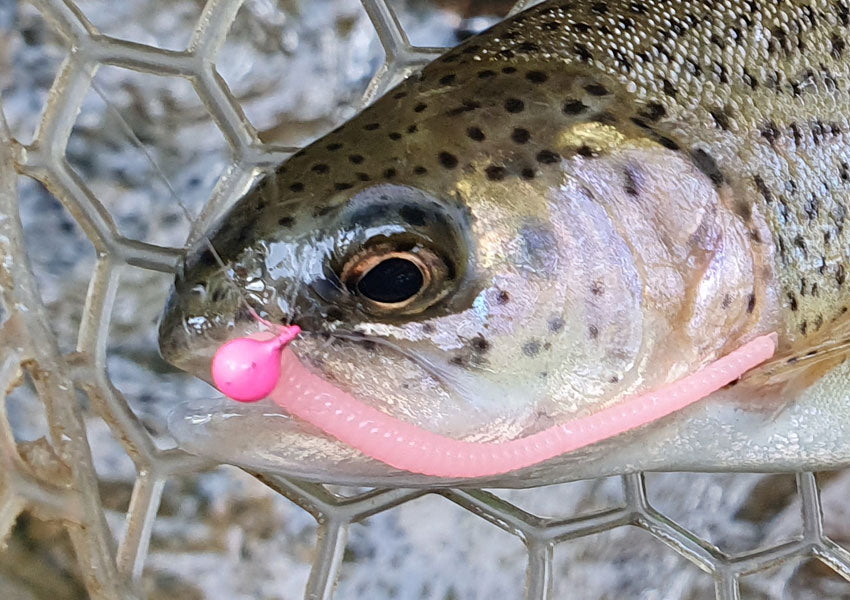Trout worms are amazingly versatile soft plastic lures that can catch everything from trout to panfish, bass, steelhead and even salmon! No longer a secret, trout worms are now used by anglers all over the world.
The truth is that trout worms are really nothing more than a piece of soft plastic in the shape of a worm. Though their simplicity can be deceptive. In the water these lures take on the look of a living thing. In additional, they are designed in a way that makes them appear to “come to life” with even the slightest movement.
In this guide we will cover some of the best ways to fish with trout worms. You’ll learn how to rig trout worms and how to fish them. This information applies equally to our custom trout worms as well as other trout worms on the market.
Rigging and fishing trout worms
There are many ways to fish trout worms. The most basic is simply to run a hook through the lure and toss it out. This will work in the right conditions. Though there are usually more effective methods.
One of the best ways to fish a trout worm is to drift the lure under a float. Start by attaching a small bobber like the Trout Magnet E-Z Float or our ball floats to your mainline (clear 4 pound monofilament or fluorocarbon line covers most situations).
A few feet below your float, tie on round jig head. Next, insert the hook point into the front or “nose” of the worm. Run the hook through the worm until you reach the hook bend. Then, bring the hook point back out of the worm. You are now ready to float fish with a trout worm.

In moving water, cast upstream and let your worm float naturally with the current. If your worm hits the bottom it is too deep. If the worm is just under the surface, it is too shallow. Adjust your float so that the worm gets in front of the fish. Keep the float moving the same speed as the current. When your float pauses, stops, or goes under water, set the hook!
You can also use this rig in still water lakes and ponds. You can try casting out the rig and letting it sit a few feet off shore. Cruising trout will sometimes hit worms sitting still in the water. If that doesn’t work, wiggle your float every minute or so. This will make the worm “dance” in the water, enticing fish like trout, bluegill and crappie to bite.
In some situations it may help to remove the float. You can then jig your worm through the water looking for active fish. This will sometimes catch fish that a dead drift will miss. You can also drag your worm along the bottom to catch fish looking down for a meal.
Wacky rigging trout worms
Another popular way to fish trout worms is the “wacky rig.” Tie a jig head or mosquito hook to the end of your line. Then, run the hook point through the middle of a trout worm and directly out the other side. The ends of the worm should hang on both sides of the hook.
Next, add a round split shot on your line for weight. Finally, cast the worm out to likely spots.

Let the worm sink for a few seconds before giving your tip tip a few small snaps. The idea is make the worm wiggle in the water. With the hook in the middle of the worm there is a lot of room for the lure to move.
The wacky worm rig works for trout as well as bass. We’ve caught some surprisingly large bass by using this method with our trout worms.
Angler’s Emporium trout worms
Angler’s Emporium trout worms are hand made in the United States. They come in two sizes. The traditional 3″ size is best for full sizes trout, steelhead, salmon and bass. The smaller 2-3/8″ size is great for hook shy trout and rock bass.
Keep in mind that we’ve caught very large fish on the small worms too. So don’t let your guard down even when using these smaller lures. They’re great for pressured fish of all sizes that have already seen lots of bait and lures.
Our trout worms come in scented and unscented varieties. The addition of scent can cause fish to hold on a little longer. Though in some cases using scented lures is not desirable or even allowed.
Trout worms come in many colors. We sell 26 different colors ourselves. Generally speaking, pink is probably the most popular color. Though others obviously work too. Read our guide to trout worm colors if you need help with lure selection.







